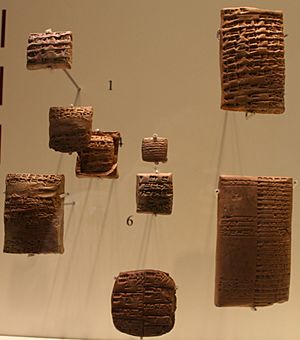Clay tablet facts for kids
Clay tablets were a very important way people wrote things down a long, long time ago. Imagine writing on a piece of soft clay instead of paper! These tablets were used in a region called the Fertile Crescent, which is in the Middle East, starting around 5,000 BC.
Contents
What Are Clay Tablets?
A clay tablet is simply a flat piece of clay. People used a special tool called a stylus to press symbols into the soft clay. It was a bit like writing with a stick on wet sand, but much more permanent! If someone made a mistake, they could smooth out the clay and try again.
How Were Clay Tablets Made?
After the writing was finished, the soft clay tablet needed to become hard. People would either leave the tablet out in the sun to dry, or they would bake it in a fire. Sun-baked tablets could be made wet again and reused. But the tablets that survived for thousands of years were the ones baked in a fire. This made them very strong and durable.
Who Used Clay Tablets?
The first people to widely use clay tablets were the Sumerian civilization in Mesopotamia. This was a very old civilization in what is now modern-day Iraq.
The writing system they used was called Cuneiform. It was one of the earliest forms of writing. Many different civilizations and languages later adopted and used the cuneiform system on clay tablets.
What Did People Write on Them?
People wrote all sorts of things on clay tablets! They recorded laws, stories, poems, business deals, and even math problems. These tablets give us amazing clues about how ancient people lived and thought. For example, some tablets contain famous stories like the Epic of Gilgamesh. Others show how ancient Babylonians understood complex math, like the Plimpton 322 tablet which deals with Pythagorean triples.
Images for kids
-
A Sumerian clay tablet with the poem Inanna and Ebih. This tablet is at the University of Chicago Oriental Institute.
-
The Babylonian Plimpton 322 clay tablet. It shows numbers written in cuneiform script and is believed to be about 1800 BCE.
See also
 In Spanish: Tablilla de barro para niños
In Spanish: Tablilla de barro para niños





